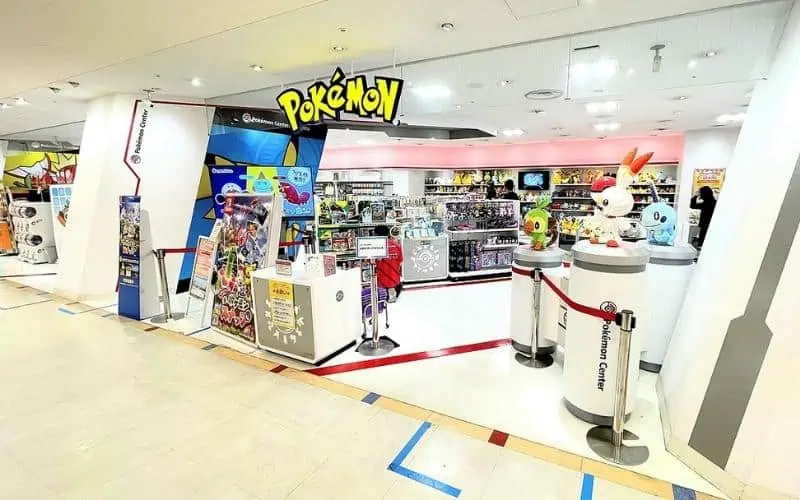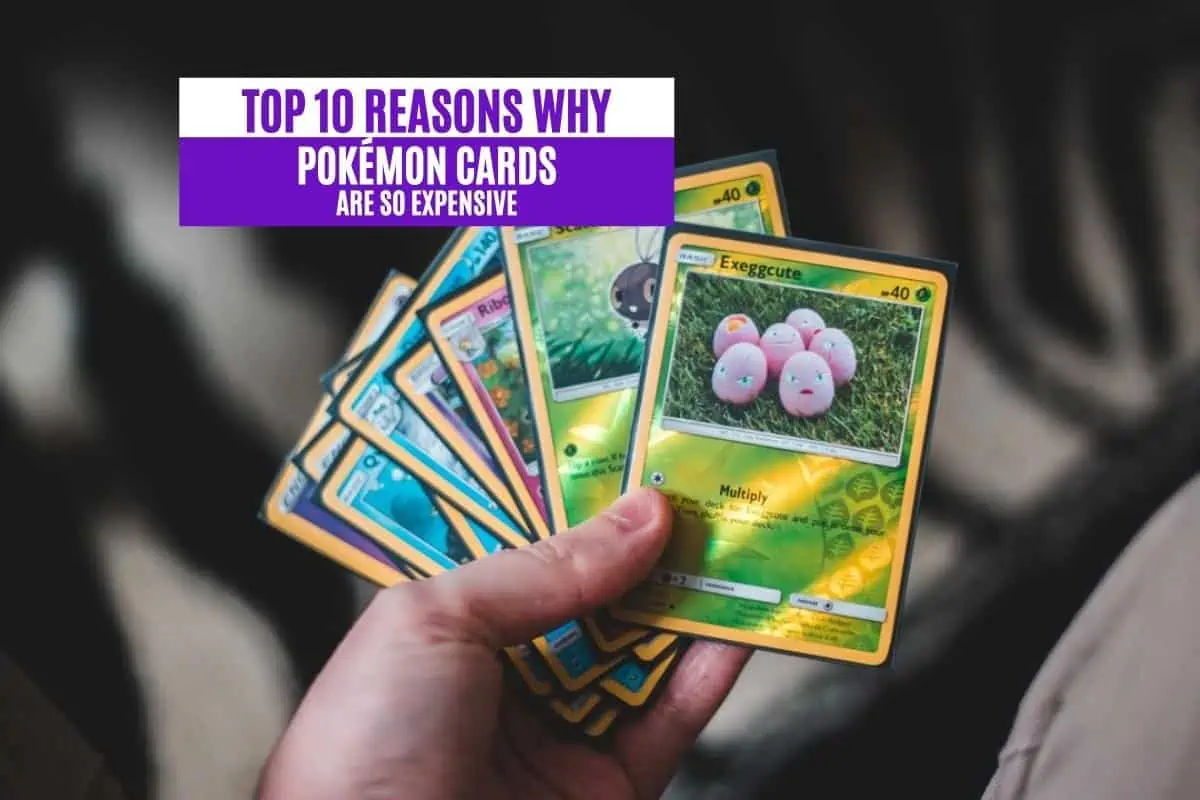People buy up billions of Pokémon cards each year, making the trading card game (TCG) one of the most profitable in the world. One pack of Pokémon cards costs between $4 and $10, depending on the pack type, but some individual Pokémon cards cost thousands or hundreds of thousands of dollars. So, why are Pokémon cards so expensive?
Pokémon cards are expensive because they’re considered worthwhile investments. The costliest Pokémon cards tend to be the oldest created for the English-speaking market. Some of these cards feature small mistakes that make them more desirable. The oldest and rarest cards cost thousands of dollars.
Do you have a stack of old Pokémon cards lingering in your attic? You might want to grab them and dust them off, especially after checking out these top reasons why Pokémon cards are so expensive.
Here Are the Top 10 Reasons Why Pokémon Cards Are Expensive
- Pokémon cards are considered worthwhile investments
- Cards with mistakes are desirable
- Some cards are extremely rare
- The supply of cards is limited
- Demand has increased for more than a decade
- First editions cards are hard to find
- Older cards have nostalgic value
- There are several versions of each card
- People want to buy their favorites
- The Pokémon franchise is popular
10. The Pokémon Franchise Is Popular

Pokémon (originally called Pocket Monsters in Japan) has been a popular franchise for almost three decades. Though the cards predate the television show, the Pokémon television series helped spread and boost the popularity of the original Pocket Monsters TGC.
By the late 1990s, the Pokémon franchise had made it big in Japan, the United States, and the United Kingdom. Its popularity soon spread into almost every corner of the world, captivating the hearts and imaginations of children everywhere.
But this popularity wasn’t a short-lived trend. Instead, the Pokémon franchise’s popularity has increased immensely since its late-90s introduction onto the world stage.
Thus far, the franchise has generated seven television series, multiple miniseries, Japanese variety shows, and almost two dozen animated films.
Pokémon plushies, posters, clothing, and other forms of merchandise continue to outsell other franchise items. Once relegated to the Nintendo Game Boy and Game Boy Color, Pokémon video games are now available on modern consoles like the Nintendo Switch.
Thanks to Pokémon GO, you can even catch virtual Pokémon with your smartphone! In short, Pokémon’s popularity has only increased with time, making the Pokémon trading cards more valuable than other types of trading cards.
Additionally, almost everyone has a favorite Pokémon, and they’ll pay big bucks to own the cards associated with their favorite creature.
9. There Are Several Versions of Each Card
Pokémon cards change every few years, introducing new designs and illustrations for each generation. Thus far, there are eight generations. There are also unique promotional cards, limited release cards, and rare event-related cards.
This, of course, is not to mention the fact that different card designs were released for English-speaking audiences and Japanese audiences throughout the years.
Almost every Pokémon card has a few iterations, making collecting specific cards an expensive hobby. After all, some cards cost $300,000 or more!
So, franchise fans eager to own every card related to their favorite Pokémon might need to be willing to invest half a million dollars.
8. People Want To Buy Their Favorites
When you buy a pack of Pokémon cards, you’re getting a randomized set of cards that may or may not contain the cards you’re looking for. This randomness is part of the gamble of investing in card packs.
But it’s also one of the major contributing factors to why Pokémon card fanatics end up spending hundreds of dollars on cards.
After all, fans typically want to own cards representing their favorite Pokémon. But getting that card by pure chance is incredibly rare. For that reason, many fans of specific Pokémon are willing to spend more on an individual card with their favorite Pokémon on the front.
Fans might also want to acquire all of the cards associated with their favorite Pokémon. But amassing such a collection isn’t easy.
For example, Tangela appears on 23 unique Pokémon cards. If you wanted to own each of these for a personal collection, you’d likely need to spend about $70.
But if your favorite Pokémon is Pikachu, you’ll need to spend $5,000 or more! There are more than 190 Pokémon cards featuring this easily recognizable yellow-and-brown mascot. Some of these cards cost more than $100 each.
So, depending on which Pokémon ends up being your favorite, you might spend a small fortune to own all of its associated Pokémon cards. Still, the most expensive Pokémon characters to collect tend to be those from the original set of 151.
7. Older Cards Have Nostalgic Value
Like the most expensive bonsai trees, the oldest Pokémon cards tend to be the most costly. After all, preserving a decades-old item is challenging, making mint condition cards particularly valuable and rare.
But nostalgia is another factor increasing the value of older first-generation cards.
Many of the first North American Pokémon card collectors are now in their late 20s and early 30s. They have expendable cash to spend on personal interests, including Pokémon cards!
Young adults looking to relive a small slice of their children or fulfill a childhood dream (trying to ‘catch’ them all) are often willing to spend a few hundred dollars on some Pokémon cards. In fact, nostalgia-based marketing has become a trend over the last several years due to increased demand for nostalgia-related items.
Of course, finding First Edition cards (the earliest printed for the North American market) is tricky, and most cost several hundred dollars each.
6. First Edition Cards Are Hard to Find
If you’re hoping to take a trip back to the late 1990s, you don’t need a time machine. Instead, you only need a deck of First Edition Pokémon cards!
These were the first Pokémon cards made by Wizards of the Coast, the company responsible for introducing the United States market to Pokémon trading cards. They were released at the start of January and soon sold out.
Many of these initial cards ended up in the hands of young children, many of whom weren’t particularly gentle or careful with their cards. As a result, finding First Edition cards in excellent condition is highly unlikely, making well-kept First Edition incredibly valuable.
But demand for these cards may increase as adults continue to buy up nostalgia items. Besides, new generations are developing their own passion for Pokémon, leading to several more decades of nostalgia-influenced prices.
5. Demand Has Increased for More Than a Decade
When Pokémon first began growing in popularity in the United States, many people thought that the trend would only last a few years and then fall into obscurity. It’s not challenging to understand why, as many children’s toys and media have disappeared from store shelves over the years.
But the Pokémon franchise shows no signs of becoming any less relevant and popular. Unlike other fads, it’s remained a stronghold of children’s entertainment for more than 20 years.
This long-term popularity has generated constant interest in Pokémon cards and other merchandise related to the franchise. And with continued interest comes higher prices, as fans are willing to pay higher prices to own a piece of their favorite franchise.
Another factor influencing the high cost of Pokémon cards is the low supply of specific cards, particularly cards released before 2000.
These older cards were either released in small quantities for a limited time or are in scarce supply nowadays due to the irresponsible actions of owners who were children during the 1990s.
4. The Supply of Cards Is Limited
The companies that produce and print Pokémon cards typically create billions of cards each year. So, you might be surprised to learn that the supply of cards is limited!
That’s because specific sets of Pokémon cards come and go. So, for example, if you wanted to own a first-generation Pokémon card from the Fossil Deck, you’d end up paying more than for a common card from a recently released deck.
After all, cards can get lost or are ruined, reducing their initial numbers. Remember, young children are the target demographic for Pokémon, so many cards don’t enjoy long lifespans.
In addition to decreased supply (over time, especially), some cards are exceptionally rare.
Some of these cards experienced short release times. Others were gifts for champions of Pokémon card competitions. But they’re all worth more than the average card.
3. Some Cards Are Extremely Rare
Rarity almost always makes something more expensive, and that’s true of both the world’s most expensive cars and the priciest Pokémon cards.
So when the supply of an item is low, and there are also rare versions mixed in with common ones, those hard-to-find examples will naturally become incredibly valuable.
Imagine this: the world’s supply of bananas is extremely low. This low supply (coupled with the high demand for bananas) generates a price increase of several dollars per banana. But then people discover that a specific type of banana tastes better than the rest, but it’s scarce.
A large group of people would likely be willing to pay abnormally high prices to enjoy that slightly tastier banana. This concept also applies to Pokémon cards, even though they’re not edible.
If only a hundred of a specific card exist, then the demand for that card skyrockets. Additionally, because Pokémon is an international phenomenon, people from all over the planet would be interested in owning one of those 100 cards.
So, when one of these rare cards goes to auction, only the most dedicated and financially capable bidders will be able to afford it. This rarity-equals-value mindset is why the 1999 First Edition Holographic Charizard (one of only 102 printed) often sells for $300,000 or more.
This type of exclusivity is one of the significant factors influencing Pokémon card prices. And nothing could be more rare and prized among the trading card community than a card with a printing error.
2. Cards With Mistakes Are Desirable
Printing mistakes happen, which often contribute to the misprinted work’s value. After all, passionate fans typically want to own a unique piece of their favorite franchise or book.
And while some Pokémon cards get their value from their general rarity or age, misprinted Pokémon cards get their massive value due to scarcity and reputation. In addition, each misprint has an origin story, making it slightly more unique than standard rare cards.
The Mewtwo with an upside-down logo marking, the first generation cards with misprinted copyright years, and the cards with Magic: The Gathering backs are all worth more due to their errors and exciting origin stories.
Collectors are often willing to spend hundreds or thousands of dollars to own a Pokémon card with a notable imperfection. Due to this high perceived value, investors have taken notice of these colorful trading cards.
After all, when a large percentage of the population is willing to pay hundreds of dollars to own an item in limited supply, that item will likely continue to hold its worth for quite some time. This quality makes Pokémon cards attractive to investors looking to grow their net worth via collectible investments.
1. Pokémon Cards Are Considered Worthwhile Investments
Investing in rare and valuable goods can protect you from economic downturns and inflation. Goods that tend to increase in value over time are often the best investments.
For this reason, many people buy gold, silver, and rare coins. But nowadays, collectible items might be the better option. For example, thousands (if not hundreds of thousands) of people buy high-priced LEGO sets as a form of financial investment.
That’s because many LEGO sets appreciate over time, making them worthwhile investment opportunities. Pokémon cards experience a similar type of appreciation, with many increasing in value with the passing years.
Unlike their older counterparts, many adults choose to spend their money on rare and pricey Pokémon cards instead of investing in precious metals. As this trend continues, the perceived value of these cards is likely to increase, making them even more valuable for investors and collectors.
Even better, Pokémon cards are a worldwide phenomenon. Consequently, they’re an investment that holds international worth. This feature makes Pokémon cards one of the best pop-culture-related investments on the planet.
Do you have an old shoebox full of Pokémon cards from your childhood? Now might be the best time to revisit them, slip them into individual plastic sleeves or cases, and start taking excellent care of them.
After all, those cards could be worth thousands of dollars today and hundreds of thousands of dollars in a decade or so!
Why Are Pokemon Cards So Expensive?
Why are Pokémon cards so expensive? The primary reason might be that they’re investments, with many cards appreciating in value over time.
That said, some cards are expensive due to printing mistakes or scarcity. Typically, shadowless and First Edition Pokémon cards are often the priciest ones.
Are you curious to learn more about the world’s most expensive entertainment? If so, check out these related articles now!

